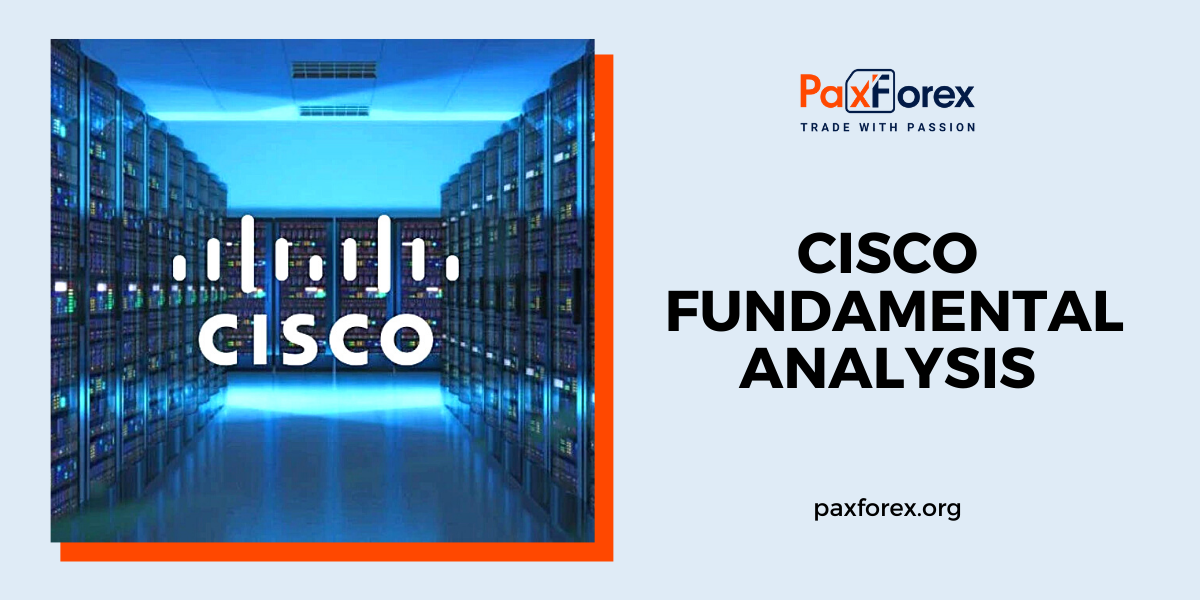
Source: PaxForex Premium Analytics Portal, Fundamental Insight
Cisco Systems, a prominent technology player known for its networking hardware and cybersecurity solutions, released its Q1 2025 fiscal earnings on November 13. The company reported $13.8 billion in revenue, aligning with the upper end of its projections but showing a 6% decline compared to the same quarter last year. Despite this revenue dip, Cisco exceeded expectations on earnings per share, posting a GAAP EPS of $0.68 and a non-GAAP EPS of $0.91. Strong gross margins and favorable tax effects contributed to this EPS outperformance, making for a mixed quarter overall, with notable strengths in security segment growth but offset by declines in key areas like networking.
Cisco has been working to shift its business model from a hardware-heavy focus to a broader software and services approach, aiming for more recurring revenue streams. This transition is central to its long-term strategy, which emphasizes network infrastructure upgrades, expanded cybersecurity offerings, and AI integration. The company’s recent acquisition of Splunk is a key part of its strategy, bolstering Cisco’s security capabilities, particularly in AI-powered threat detection. Investments in high-speed connectivity and network convergence are also essential to maintaining a competitive edge as the tech landscape continues to evolve.
During Q1, Cisco demonstrated resilience amid challenges, with its revenue decline primarily tied to a 23% drop in demand for networking products—its largest business segment. However, the company’s non-GAAP EPS of $0.91 surpassed expectations, supported by operational efficiencies and a stronger-than-anticipated gross margin of 69.3%. These results suggest effective cost management and pricing strategies that helped mitigate some of the revenue headwinds.
Geographically, Cisco’s performance varied. Revenue in the Americas and EMEA (Europe, Middle East, and Africa) regions fell, while APJC (Asia Pacific, Japan, and China) experienced modest growth. The shift from product to service-based revenue was evident, with product sales decreasing by 9% and service revenue rising by 6%. This shift aligns with Cisco’s efforts to balance its product portfolio with service offerings, enhancing stability and long-term growth potential.
A standout performance came from Cisco’s security segment, which recorded a remarkable 100% year-over-year increase, largely due to the integration of Splunk’s products. This growth underscores the success of Cisco’s acquisition strategy, particularly in enhancing its security portfolio. Deferred revenue also increased by 7%, reflecting greater customer commitments to software subscriptions and service contracts, which are critical to Cisco’s recurring revenue goals.
Cisco's fiscal Q1 results did not include any significant one-time financial events. However, the integration of Splunk may bring restructuring costs over time, potentially impacting future financials. The company’s dividend policy remained unchanged, continuing its commitment to returning capital to shareholders.
Looking ahead, Cisco projects Q2 revenue between $13.75 billion and $13.95 billion, with an expected non-GAAP EPS range of $0.89 to $0.91. For fiscal 2025, Cisco forecasts revenue between $55.0 billion and $56.2 billion, with non-GAAP EPS between $3.60 and $3.66, indicating a steady outlook. This guidance reflects cautious optimism as Cisco continues its shift towards software and services, focusing on growth areas like AI and cybersecurity.
Investors will likely keep an eye on Cisco’s progress in integrating acquisitions like Splunk and expanding its presence in AI and security markets. The company’s ability to drive service revenue growth while reversing declines in product sales remains crucial. As Cisco pursues strategic pivots in network optimization and AI, its adaptability to shifting market demands will be key to sustaining long-term growth and profitability.
As long as the price is above 56.00, follow the recommendations below:
- Time frame: D1
- Recommendation: long position
- Entry point: 57.80
- Take Profit 1: 60.00
- Take Profit 2: 62.50
Alternative scenario:
If the level of 56.00 is broken-down, follow the recommendations below:
- Time frame: D1
- Recommendation: short position
- Entry point: 56.00
- Take profit 1: 54.00
- Take Profit 2: 52.50













